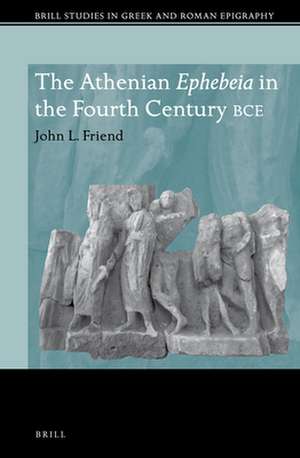The Athenian <i>Ephebeia</i> in the Fourth Century BCE: Brill Studies in Greek and Roman Epigraphy, cartea 13
Autor John L. Frienden Limba Engleză Hardback – 28 aug 2019
Din seria Brill Studies in Greek and Roman Epigraphy
- 18%
 Preț: 859.57 lei
Preț: 859.57 lei - 18%
 Preț: 1016.30 lei
Preț: 1016.30 lei - 18%
 Preț: 844.89 lei
Preț: 844.89 lei - 18%
 Preț: 630.45 lei
Preț: 630.45 lei - 49%
 Preț: 790.94 lei
Preț: 790.94 lei - 18%
 Preț: 653.72 lei
Preț: 653.72 lei - 18%
 Preț: 690.77 lei
Preț: 690.77 lei - 18%
 Preț: 578.01 lei
Preț: 578.01 lei - 18%
 Preț: 620.32 lei
Preț: 620.32 lei - 18%
 Preț: 600.54 lei
Preț: 600.54 lei - 18%
 Preț: 679.67 lei
Preț: 679.67 lei - 15%
 Preț: 359.10 lei
Preț: 359.10 lei - 18%
 Preț: 845.87 lei
Preț: 845.87 lei - 18%
 Preț: 722.94 lei
Preț: 722.94 lei - 18%
 Preț: 820.28 lei
Preț: 820.28 lei - 18%
 Preț: 674.28 lei
Preț: 674.28 lei
Preț: 607.68 lei
Preț vechi: 741.07 lei
-18% Nou
Puncte Express: 912
Preț estimativ în valută:
116.28€ • 124.34$ • 96.95£
116.28€ • 124.34$ • 96.95£
Carte indisponibilă temporar
Doresc să fiu notificat când acest titlu va fi disponibil:
Se trimite...
Preluare comenzi: 021 569.72.76
Specificații
ISBN-13: 9789004402041
ISBN-10: 9004402047
Dimensiuni: 155 x 235 mm
Greutate: 0.59 kg
Editura: Brill
Colecția Brill
Seria Brill Studies in Greek and Roman Epigraphy
ISBN-10: 9004402047
Dimensiuni: 155 x 235 mm
Greutate: 0.59 kg
Editura: Brill
Colecția Brill
Seria Brill Studies in Greek and Roman Epigraphy
Notă biografică
John L. Friend, Ph.D. (2009), University of Texas, is Assistant Professor of Classics at the University of Tennessee. He has published on the Athenian ephebeia and Greek warfare, most recently in Ancient Documents and Their Contexts (Brill, 2014).
Recenzii
"(...) the work is destined to become the principle reference tool for the ephebic inscriptions of the Lycurgan period, replacing Reinmuth’s 1971 catalogue." - Nicholas Sekunda, University of Gdańsk, in: Bryn Mawr Classical Review, 2020.11.20
''(...) this book represents a valuable contribution not just to the history of the Athenian ephebeia, but also to our ever-richer picture of the texture of Athenian civic life in the last third of the fourth century.'' Polly Low, in The Classical Review 70.2 (2020)
''(...) this book represents a valuable contribution not just to the history of the Athenian ephebeia, but also to our ever-richer picture of the texture of Athenian civic life in the last third of the fourth century.'' Polly Low, in The Classical Review 70.2 (2020)
Cuprins
PrefaceAcknowledgementsList of FiguresAbbreviations
1 Introduction
2 An Aeschinean Ephebeia?2.1The Controversy2.2Origin of Ephebos2.3Training before Chaeronea?2.4Aeschines’ Peripoleia2.5Aeschines without the Ephebeia
3 The Creation of the Ephebeia3.1The Law of Epicrates3.2Reaction to Chaeronea?3.3The Defense of Attica3.4The Destruction of Thebes3.5Lycurgus and the Ephebeia
4 The Defenders of Athens4.1Kosmetes and Sophronistes4.2Strategoi and Peripolarchoi4.3Eutaxia: Discipline in the Ephebeia4.4Training Ephebes4.5Espirit De Corps
5 Ephebes and the Ephebeia5.1Citizen Participation5.2Exemptions and Citizenship5.3The Motivation to Serve5.4The “Bad” Ephebe5.5Persuasion or Coercion?5.6Honors during Service5.7Honors after Service
6 Educating Ephebes6.1The Need for an Ephebic Paideia6.2Sophrosyne in the Ephebeia6.3Patriotism, Glory, and Self-Sacrifice6.4Festival Participation6.5Ephebes as Liminal Figures?
7 Epilogue: After Lycurgus
Catalogue
BibliographyIndex of Names and SubjectsIndex of InscriptionsIndex of Literary Sources
1 Introduction
2 An Aeschinean Ephebeia?2.1The Controversy2.2Origin of Ephebos2.3Training before Chaeronea?2.4Aeschines’ Peripoleia2.5Aeschines without the Ephebeia
3 The Creation of the Ephebeia3.1The Law of Epicrates3.2Reaction to Chaeronea?3.3The Defense of Attica3.4The Destruction of Thebes3.5Lycurgus and the Ephebeia
4 The Defenders of Athens4.1Kosmetes and Sophronistes4.2Strategoi and Peripolarchoi4.3Eutaxia: Discipline in the Ephebeia4.4Training Ephebes4.5Espirit De Corps
5 Ephebes and the Ephebeia5.1Citizen Participation5.2Exemptions and Citizenship5.3The Motivation to Serve5.4The “Bad” Ephebe5.5Persuasion or Coercion?5.6Honors during Service5.7Honors after Service
6 Educating Ephebes6.1The Need for an Ephebic Paideia6.2Sophrosyne in the Ephebeia6.3Patriotism, Glory, and Self-Sacrifice6.4Festival Participation6.5Ephebes as Liminal Figures?
7 Epilogue: After Lycurgus
Catalogue
BibliographyIndex of Names and SubjectsIndex of InscriptionsIndex of Literary Sources
